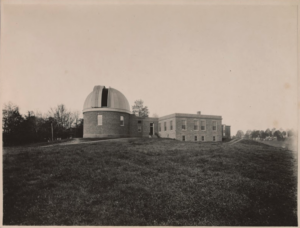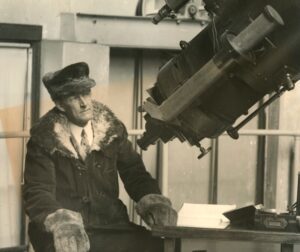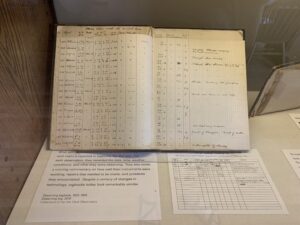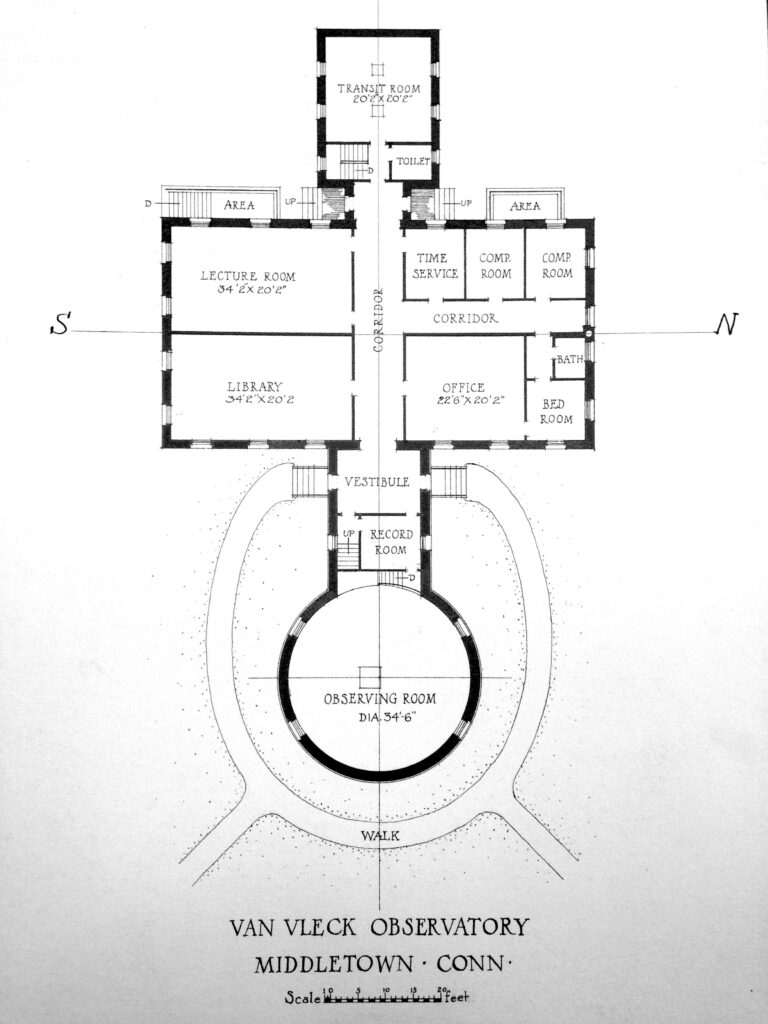By Amrys O. Williams
On June 16, 1916, nearly 70 people gathered on the Wesleyan University campus to dedicate the college’s first purpose-built astronomical observatory. Named in honor of John Monroe Van Vleck, who had taught mathematics and astronomy at Wesleyan from 1853 to 1904, the building was the product of two years of construction, a generous gift from the namesake’s family, and design negotiations between the architect, Henry Bacon (known today for the Lincoln Memorial), and the observatory’s first director, astronomer Frederick Slocum.
 While certainly a moment for local celebration, the opening of the Van Vleck Observatory was an important moment for astronomy as well. Among the first signatures in the visitors’ book—still in the observatory’s collections and now digitized— were those of astronomers who had traveled from observatories at Northwestern University, Swarthmore College, and even the new Mount Wilson Observatory in California. As reported in the Publications of the American Astronomical Society 3 (1918), the scientists had convened with Slocum and others at the AAS meeting the year before to launch a research program across nine institutions with an enormous goal: determining the distances to the stars. They were together again that June day to welcome the Van Vleck Observatory to a defining astronomical project of the 20th century.
While certainly a moment for local celebration, the opening of the Van Vleck Observatory was an important moment for astronomy as well. Among the first signatures in the visitors’ book—still in the observatory’s collections and now digitized— were those of astronomers who had traveled from observatories at Northwestern University, Swarthmore College, and even the new Mount Wilson Observatory in California. As reported in the Publications of the American Astronomical Society 3 (1918), the scientists had convened with Slocum and others at the AAS meeting the year before to launch a research program across nine institutions with an enormous goal: determining the distances to the stars. They were together again that June day to welcome the Van Vleck Observatory to a defining astronomical project of the 20th century.
The distance from Earth to the stars grounds our understanding of the universe: its scale, its age, and its history. Astronomers have long known, in theory, how to figure out stellar distances using the phenomenon of parallax. We are all familiar with how our eyes allow us to determine the relative distances of objects by giving us two views from slightly different angles. Hold your thumb at arm’s length and alternate closing your eyes. Your thumb will appear to jump back and forth against the background. The mathematics is simple: if you measure the distance between your eyes and the angle they subtend, it is basic trigonometry to determine the length of your arm.
Using Earth’s annual motion around the sun to create two different views six months apart, astronomers could determine a star’s parallax and, thus, its distance. But the distances were so vast and the angles so tiny that their measurements needed to be incredibly exact—far more so than they could reliably measure by eye. When the technology of photography revolutionized astronomy at the turn of the 20th century, astronomers could finally take and compare pictures of the sky precisely and systematically, unleashing a profusion of parallax studies at Van Vleck and around the world.
Even with the aid of photography, calculating parallax was a massive undertaking, which involved demanding and often tedious work. Van Vleck’s phase of the project illuminates the working practices of astronomy at the start of the 20th century. The observatory’s layout, its research program, and its artifacts and records help us understand a moment in the recent past when scientific data was not the eminently transferrable strings of ones and zeroes that define the digital age. Van Vleck’s story also reminds us of the physicality of information, the people who helped create and digest it, and the work involved in its capture, both material and intellectual. It reveals the multisite nature of astronomical research in the 20th century and the significant contributions made in Connecticut to our understanding of the universe.
The Work of the Observatory
 A photograph of Frederick Slocum tells us much about the practice of astronomy in the early years of the observatory. Slocum is seated at Van Vleck’s 20-inch refracting telescope, clad from head to toe in furs, down to tall furry boots on his feet and thick fur-lined gloves on his hands.
A photograph of Frederick Slocum tells us much about the practice of astronomy in the early years of the observatory. Slocum is seated at Van Vleck’s 20-inch refracting telescope, clad from head to toe in furs, down to tall furry boots on his feet and thick fur-lined gloves on his hands.
While today a telescope operator sits in a warm room, directing observations remotely with the aid of a computer, in Slocum’s day, observing was an active, physically demanding undertaking that, though technically indoors, was essentially an open-air pursuit. Observing logs still held at Van Vleck demonstrate that, to avoid humidity that might refract light or condense on the lenses and fog the image, Slocum and his colleagues made as many observations as possible in the winter. They observed in an unheated dome set off from the rest of the building to avoid temperature differences that could create air currents and distort their images.
 As the logbooks show, on most nights, Slocum stayed up late, taking photographs of the stars. Each exposure ran approximately five minutes, some as long as twenty. During that time, Slocum made sure the telescope’s clockwork mechanism was tracking properly to counteract the rotation of the earth—and adjusting the scope manually if it wasn’t—so that his hard-won photograph would depict a star field of clear, tiny dots rather than ovals or blurred lines. For insurance and to save on the cost of photographic plates, he took one image, then moved the plate two millimeters and captured the same field again—a process he described in an article on stellar distances that appeared in Popular Astronomy in March 1942. He transferred each plate to a mobile darkroom in the dome and, at the end of the session, brought them all to the basement darkroom. Slocum caught a few hours of sleep until the predawn hours when he would make more observations. Then, he began a day of teaching classes, developing plates, checking clocks, supervising staff, and all the other work that kept the observatory running.
As the logbooks show, on most nights, Slocum stayed up late, taking photographs of the stars. Each exposure ran approximately five minutes, some as long as twenty. During that time, Slocum made sure the telescope’s clockwork mechanism was tracking properly to counteract the rotation of the earth—and adjusting the scope manually if it wasn’t—so that his hard-won photograph would depict a star field of clear, tiny dots rather than ovals or blurred lines. For insurance and to save on the cost of photographic plates, he took one image, then moved the plate two millimeters and captured the same field again—a process he described in an article on stellar distances that appeared in Popular Astronomy in March 1942. He transferred each plate to a mobile darkroom in the dome and, at the end of the session, brought them all to the basement darkroom. Slocum caught a few hours of sleep until the predawn hours when he would make more observations. Then, he began a day of teaching classes, developing plates, checking clocks, supervising staff, and all the other work that kept the observatory running.
The work of the parallax program was distributed across many institutions for two simple reasons: material and human. The material reason was glass. The photographs Slocum and his colleagues took each night through Van Vleck’s twenty-inch refracting telescope were glass plate negatives, each five by seven inches. Glass provided a rigid surface that would yield reliable measurements at the particular scale—down to the ten-thousandth of a millimeter—required by the parallax project. Glass would not bend, stretch, expand, or contract. But it was heavy and fragile, impossible to transport safely to a central location without breaking the lot, so plates were developed and measured on-site.
The human reason was the workforce required to carry out the project. After all, calculating parallax involved not just astronomy but also clerical work and mathematics. As shown in the Publications of the Van Vleck Observatory (Wesleyan University, 1938), observing, capturing, and developing plates was the start of a painstaking process that could take years to find the parallax of a single star. The observatory’s initial staff of three astronomers and one secretary grew to include more measurers and computers, many of them women with mathematical and astronomical expertise. These included Lois Slocum, Frederick Slocum’s niece; Mildred Booth Stearns, Professor Carl L. Stearns’s wife, who had worked as a computer at Yale; and the observatory’s administrative staff through the 1990s, who also measured star plates.
Observatory staff filed each developed plate until the star in question had been observed at least 20, sometimes 30, times in pairs six months apart. Redundancy reduced the likelihood of errors, but it took meticulous organization: planning out what stars to observe each night, maintaining logs, and keeping track of which plates corresponded to which stars so that, when the time came to measure and calculate a star’s parallax, the correct plates could be pulled.
As Slocum explained in his address at the observatory’s dedication, published in the August–September 1916 issue of Popular Astronomy, the layout of the building reflected this workflow. In addition to the observing room, which housed the telescope, it contained an office with an adjacent bedroom and bathroom for long nights of observing; a library where staff could consult almanacs, charts, and star catalogs for planning observations; a records room for filing plates and documents; a time service room with accurate clocks that astronomers calibrated daily; a computing room where staff performed parallax calculations; and a classroom. The basement housed a darkroom, a spectroscopic laboratory, and a workshop. Everything the team needed was right there, under one roof.
Precision and Patience
To look at a glass plate negative of a stellar field is to understand the exacting precision of parallax measurement and how difficult it was to achieve. At first glimpse, the plate looks empty, perhaps a bit dirty, flecked with dozens, maybe hundreds of tiny dark specks no bigger than the period at the end of this sentence. But look closely, and you begin to see that this is a picture of the night sky, each faint fleck a star. In the center somewhere is the target or pi star: the one being observed, whose distance you are trying to determine. How do you begin?
Slocum described the process in his March 1942 Popular Astronomy article. For each pi star, Slocum and his colleagues chose several reference stars. The measurer’s task was to accurately determine the distances between the pi star and each reference star using a comparator. This device allowed the measurer to adjust the plate’s position using a precise screw. The measurer looked through an eyepiece equipped with crosshairs made of spider silk and adjusted the position of the plate to center the crosshairs on each star. The comparator readings provided the numbers for parallax calculations.
The work then moved to the computing room, where women like Lois Slocum used an averaging technique to reduce the measurements from the multiple plates taken for each star into a single representative plate. She plugged the results into a series of equations to determine the star’s parallax.
As Slocum explained in his dedicatory address, Van Vleck staff employed the latest technology to speed up its work. Lois Slocum and her computer colleagues used a mechanical calculating machine to add, subtract, and multiply numbers of up to eight digits and compute remainders for long division. Astronomy department records also show that, in 1959, the observatory purchased a device that the Air Force had used to study photographs of Soviet satellites and put it to work measuring star plates. Measurers could press a foot pedal and output their measurements directly to machine-readable punch cards. It is no accident that Wesleyan’s first digital computer was installed in 1960 in the observatory basement, where students and staff fed thousands of punch cards into the noisy reader.
The work of parallax—planning, observation, measurement, reduction, calculation—was demanding and took years, even decades. For instance, astronomers began taking plates of Ross 47, a faint star in the constellation Orion, in 1928, but it wasn’t until 1931 that they could compute its parallax. Over a quarter century after its dedication, Van Vleck published its first volume of parallaxes, Publications of the Van Vleck Observatory. The third and final volume appeared in 1960, with 129 parallaxes made between 1925 and 1958. For these 129 stars alone, astronomers had taken nearly 4,500 plates.
An Enduring Legacy
By 1963, the 14 observatories involved in the project had determined the parallaxes of nearly 6,000 stars. By the 1990s, when Van Vleck’s phase of the program ended, they had calculated nearly 16,000 parallaxes for over 8,000 stars. Today, we know approximately 100,000.
With one hundred billion stars in our galaxy alone, work remains, but it is being done far from the Van Vleck Observatory. The European Space Agency’s Gaia mission, launched in 2013, is calculating parallaxes for over a billion stars—from space. Its three-dimensional survey will provide a detailed map of our galaxy and beyond. The work of Van Vleck’s 20th-century astronomers, measurers, and computers can now be done automatically on a spacecraft.
Just as photography revolutionized astronomy at the turn of the 20th century, digital imaging transformed the field at the century’s end. Along with the space age and the connectivity of the Internet, digital photography ushered in a new era of astronomy, one linked less to places like Van Vleck. No longer did astronomers’ data come from heavy, fragile glass plates. Instead, it could be shared seamlessly and electronically. These technological transformations are one reason most observing today occurs on remote mountaintops where conditions are favorable—or, in the cases of Gaia and the Hubble and Webb telescopes, in space itself.
Although Van Vleck’s parallax program was superseded by more efficient methods of determining stellar distances in the 1990s, the cross-institutional collaboration of which it was a part remains an essential feature of scientific work in the 21st century. Looking through a telescope is always an exercise in time travel: when gazing at the stars, we are looking back in time. The distances to the stars are enormous, and in an expanding universe, they are constantly changing. It is this dynamism, not just the efficiency of a mission like Gaia, that explains why we are still determining parallaxes, albeit in new ways. By sitting with Frederick Slocum at the eyepiece of the telescope, bundled up in the darkness, trying to write clear notes in the logbook with fur mitts, and by accompanying Lois Slocum into the computing room to squint into the comparator, or to cross out an equation error and start over at the beginning, we can better understand the human side of what today can seem a truly astronomical and impossibly distant endeavor.
Amrys O. Williams is the executive director of the Connecticut League of Museums and a historian of science, technology, and the environment. She co-curated the Under Connecticut Skies exhibition on view at the Van Vleck Observatory.
Explore!
Attend a public program at the Van Vleck Observatory on the Wesleyan University campus in Middletown. For information, see the calendar at wesleyan.edu/astro/events/.
Visit the Under Connecticut Skies exhibition on view at the Van Vleck Observatory. Learn more at underctskies.wordpress.com and contact the astronomy department for visiting hours.
Learn More!
Rachele Merliss, “The Van Vleck Observatory: A Reflection of Environmental Conditions,” connecticuthistory.org/the-van-vleck-observatory-a-reflection-of-environmental-conditions



